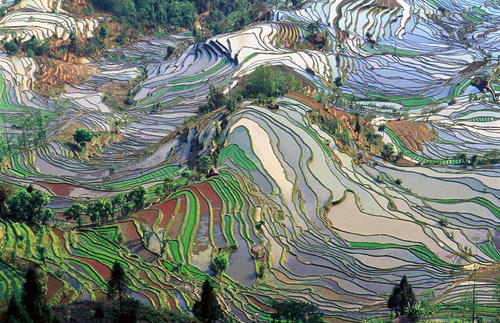Terraces
Terrace rice fields in Yunnan Province, China
Image Credit: Gao, J. (2003)
Women and men in northern Rwanda work on a public works site, building terraces to prevent soil erosion
Image Credit: DFID - UK Department for International Development (2012)
Cross sectional view of a level bench terrace
Image Credit: Suthfeldt, R. (2016)
A terrace is an earth embankment with a channel constructed across the slope at a fixed vertical interval and at an acceptable horizontal slope. Terraces are constructed to reduce erosion, to remove excess surface water, and to retain the maximum amount of moisture for crop production. Thus, it is both: a soil and water conservation measure. In mountainous areas, farming of hillsides would be nearly impossible without terraces; in dry regions, terraces increase plant available water storage and groundwater recharge.
Terraces are classified into three main classes as diversion, retention and bench type terraces. The primary aim of a diversion terrace is to intercept the overland flow and channel it across the slope to a suitable outlet. Diversion terraces are constructed on a small gradient usually 1:250 to the contour. The diversion terraces are again classified as magnum, Nichols, broad-based, and narrow-based type. The magnum type diversion terrace is constructed by taking the soil from both sides of the embankment. Taking the soil from the upslope side of the embankment only forms the Nichols type diversion terrace. The broad based type diversion terraces are constructed with embankment and channel occupying a width of 15 m. The narrow based type diversion terraces are only 3 to 4 m wide; the banks have steeper slopes, which cannot be cultivated. The retention terraces are level terraces, which are used for conserving surface water by storing it, as they are usually practiced on hillsides. Bench terraces are platform like constructions along a slope, which is used to cultivate steep slopes. This type of terraces is generally constructed on slopes < 10 % and are widely used throughout the world. Bench terraces are again classified as level bench terraces, bench terraces sloping outward, and bench terraces sloping inward.
(Awulachew et al. 2009, Blanco & Lal 2008)
There are two types of bench terraces: conversion and upland terraces. Conversion terraces are also referred to as irrigation or level bench terraces and are used for flood irrigation (e.g. rice) and water storage. Upland terraces are used for rain-fed and irrigated crops and are gently sloped outwardly for allowing drainage. Bench terraces are more suited to large fields with mechanized agriculture under high-value crops. (Blanco & Lal 2008)


